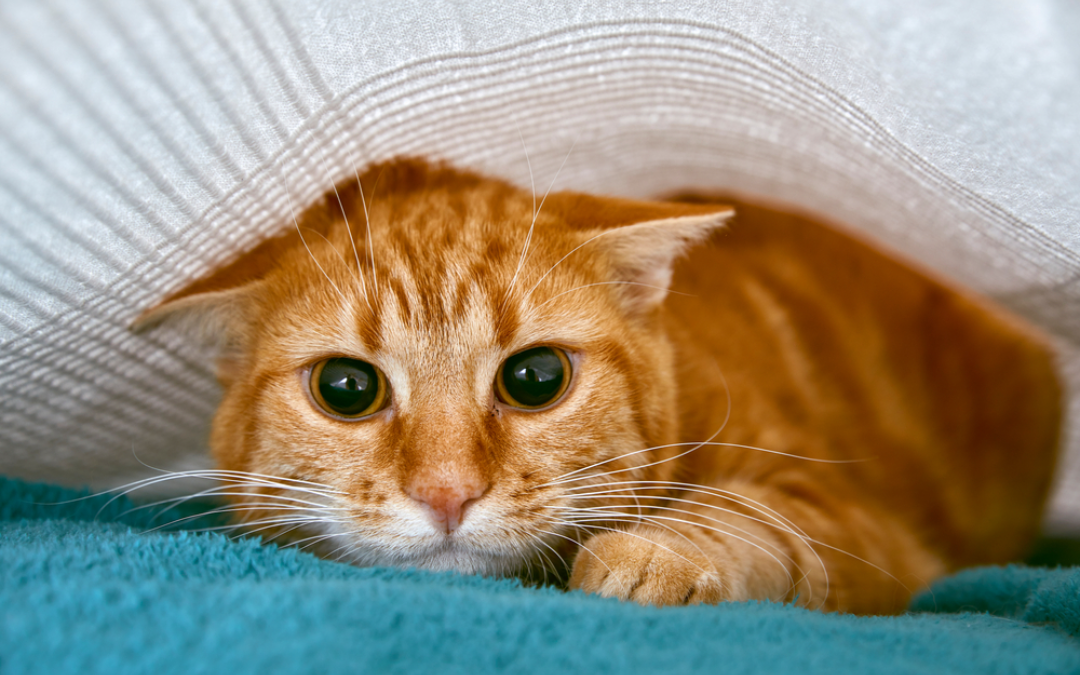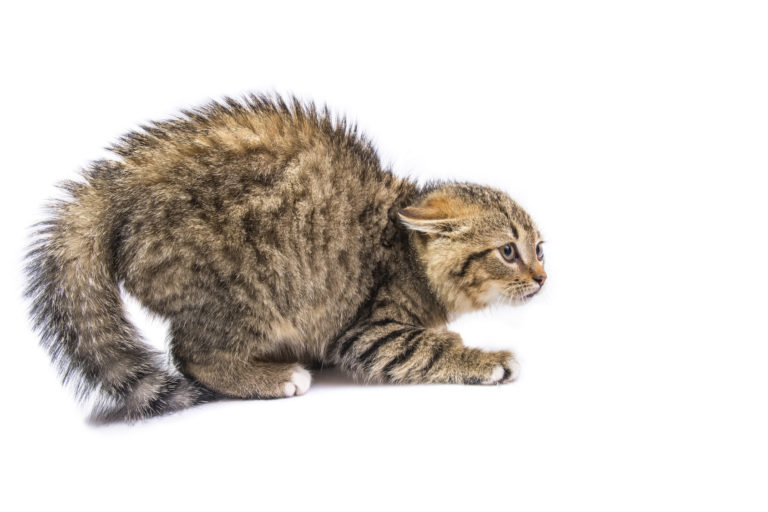Cat aggression caused by fear

Introduction
- Fear can be a normal, adaptive response, given the context. When the fearful behavior is out-of-context and normal behavioral responses are replaced by those characterized by intensive arousal and active avoidance or withdrawal, a diagnosis of fearful behavior may be involved.
- Because of the nuances of the neuroendocrine arousal system in cats, the majority of cats who are fearful are also aggressive.
- A description of behaviors that manifest when fear and aggression are both involved may relate to 2 diagnoses:
- Aggression due to lack of socialization Lack of appropriate socialization and/or habituation.
- Fear aggression.
- Cat owner interprets & complain about fear aggression primarily when humans are the focus of the attacks; however, fear aggression can focus on other cats or animals of any other species.
Signs
- Staring is the most common sign that a cat is being mean. Cats that are scared move away and twist their bodies to take up as little room as possible and be as quiet as possible. In the beginning of a new encounter, cats that are fearfully aggressive may act just like this. Fearfully aggressive cats look like scary cats on Halloween if they get caught in the open. This shows that they are reacting and want to get away. If scared cats are upset even more, they hiss, then swat, and hiss again. If they can't get away, they attack with their claws and teeth. When this happens, biting happens very quickly and can be very dangerous. As with other feline aggressions the following may occur:
- Staring
- Hissing
- Posturing, including:
- Changes in piloerection
- Tail postures
- Ear position, back or flattened.
- Pupil shape and dilation
- Back and rump posture
- Facial signs
- Swatting.
- Marking with urine or with scent gland
- Out-right attack and fighting may occur.
- No physical response before outright attack.

Acute presentation
- Cat owners usually notice that cats are fearfully aggressive when they try to handle them, move them, or compel the cats to come to them or stay with them.
- The cats freeze first, and then squirm, hiss, scratch, bite, and exhibit any other behavior necessary to get away, and then they hide.
- When located, they freeze and then burst to escape.
- Fear is distinguished from anxiety by this exaggerated avoidance and escape behavior.
- Groups of homeless cats that are not exposed to humans and handled humanely are at risk of developing aggression due to lack of socialization that may be associated with fear aggression.
Age predisposition
- If cats don't get to know people in their first few months of life, they become aggressive by the time they are 3 months old because they haven't been socialized.
- No one knows or has looked into how much this experience can be a precursor to frank fear-based violence.
- Fear aggression can happen at any age in cats who have been through horrible things, like being tortured, abused, or left alone in strange places.
- When cats are getting ready to be around other cats, their neurochemistry may be changing, making them more likely to get hurt. If this is true, then the older the cat is before the scary event, the less likely it is that it will become fear aggressive. To avoid this, understanding how to act normally might be helpful. If this idea is true, the longer the cat was able to act normally, the more likely it was that they would be able to get over something that would make another cat freak out and attack.At the moment, these theories have not been tested.
Cost considerations
- Medical care for people who are hurt costs a lot of money.
- The more troubling cost is the one that can't be seen or touched: cats that get scared and attack are hurt every time they are exposed to something that makes them angry.
- It gets harder and harder to take care of these cats as patients, which takes more time and staff and leads to less-than-ideal medicine. Because they are so difficult to handle, these snappy cats may be overrepresented in the group of cats whose illnesses are discovered when they are already far along.
- Medication is often part of the cost of care. These cats need small amounts of tricylic antidepressants (TCAs) and selective serotonin reuptake inhibitors (SSRIs) to be treated, which cost about $1 USD per day. However, mixing them together may make the cost go up.
- If the cat owners decide to separate the cats, the fights won't happen, and the cats' relationships won't change. This is also the cheapest option.
Special risks
- Any anxious cat is at an increased anesthetic risk, as they are now more sensitive to alpha adrenergic pre-anesthetic agents. If the cat is taking a TCA there is also a concern about alpha adrenergic pre-anesthetic agents. The concern is less if the medication is an SSRI. Despite this risk, Cat owners are to be advised NOT to discontinue the medication prior to anesthesia if the cat is well regulated. The procedure for which the anesthesia is warranted is undoubtedly behaviorally provocative, and these cats are more at risk for a profound reaction. Accordingly, relapse is a concern that becomes more likely if the cats are withdrawn from their medication.
- Under no circumstances should cats treated with a TCA or SSRI be treated with any agent containing a monoamine oxidase inhibitor (MAO) eg, selegiline Selegiline hydrochloride, amitraz Amitraz. These drug classes interact adversely and may lead to serotonin syndrome. Clinical signs of this include an inability to relax, sleep, calm, eat, attend to anyone or anything, and potential hyperthermia Hyperthermia. This should be viewed as a medical emergency.
None of the above medications are licensed for use in cats in the USA.
Rhythm or conduction disturbances and tachycardias have been reported for all TCAs although they are extremely rare. - This diagnosis may carry a special risk for Cat owners. Cat owners are urged to avoid physically intervening with a cat whose last option may be to bite and scratch them. Serious injuries to Cat owners requiring antibiotic treatment and, or hospitalization can occur if they try to separate actively fighting cats. Cat owners should be advised to use large pieces of cardboard, heavy blankets and other physical barriers to separate cats. Cat owners should further be aware that the cats could remain highly aroused for 24+ hours after an attack because of the very reactive neurochemistry of their hypothalamus. If the Cat owner must take the cat to a veterinary practice they need to begin to address the issue of treatment and prevention in order to not end up in a downhill spiral. Any Cat owner who has been injured by a cat should be referred to a human physician for follow-up immediately, although veterinarians should recommend immediate and dress the wound Cat scratch disease.
- If small children are involved it is important that they know how to appropriately respond to a cat that is crouching or withdrawn. Education about feline body language should be part of the normal introduction of children to pet cats. Children should be instructed not to approach, torment, reach for, stare at, or interact with these cats. Any animal that is cornered and cannot escape has the potential to attack. Children must be supervised in the presence of these cats until the adults are confident that the child will act appropriately. Children less than 5 years are sufficiently developmentally mature to have the necessary skills to assess and handle these cats.
Predisposing factors
- Primary fear aggression may be a sequelae to abuse or a condition that develops naturally because of aberrant neurotransmitter function. Additionally, secondary fear aggression may be a sequelae to aggression due to lack of socialization. We should also consider the dynamics of abandonment. If cats who are 'genetically' fearful are abandoned more frequently, the group of cats for whom aggression due to lack of socialization may be a first step in the etiology of fear aggression would not be a heterogeneous one. This is important for prognosis. A cat that is 'genetically' fearful may not be as able to respond to early social exposure as a cat without that burden, but together, factors suggest that even with huge amounts of intervention improvement may be limited.
- These abnormal cats may have a genetic predisposition, or may have had incomplete exposure to other cats while growing up. There is insufficient data on all of these topics, so no firm conclusions can be drawn; however, cats whose parents - particularly the fathers - are friendly and who were not socially deprived as youngsters have the best chance of avoiding being afflicted with these conditions.
- A full understanding of the inheritance of temperament is lacking but it is likely that the presence on the X chromosome of genes for many neurotransmitters plays a role.
How the problems develop
- For cats whose primary concern is aggression due to lack of socialization Lack of appropriate socialization and/or habituation, there is invariably a history of early lack of exposure to or interaction with humans, cats, or another species.
- Cats who have not had contact with humans prior to 3 months of age have missed sensitive periods important for the development of normal approach responses to people.
- Lack of such socialization with other cats may result in the same lack of normal inquisitive response to other cats.
- Furthermore, total isolation from cats can have negative consequences for future interaction with humans.
- This constellation of deprivation scenarios may be contributory to many of the aggressions seen in urban, feral cats, in which case the development of fear aggression may be secondary.
- For cats whose main concern is primary fear aggression it is important to remember that there are genetically friendly cats and genetically shy cats. The extent to which a cat has the potential to be outgoing depends on paternal genes. It is unclear the extent to which shy cats have the potential to become fearfully aggressive, but there are cats who, despite the best early exposure possible, become aggressive whenever fearful. These cats also may become fearful without an apparent stimulus. Once reactive at all, the threshold for aggression and further reactivity in these cats is considerably lowered.
- Cats may also become fearfully aggressive as an adaptive learning response to abandonment, inappropriate housing in shelters, and abuse. Regardless, if truly threatened, any cat - even a "normal" cat - will defend itself. The only issue is where the threshold for reactivity lies. Depending on the outcome of the treat, the cat that responds appropriately, in-context can also learn to become fearfully aggressive.
- Concomitant or co-morbid diagnoses are the rule in behavioral conditions owing to the numerous associations created under conditions of anxiety and stress.
- Behavioral, renal/urologic, and dermatological conditions are commonly seen together. Unfortunately, when a physical or somatic sign is apparent the tendency is to ignore the behavioral signs, to not ask about them, or to assume that these will resolve when the medical condition is addressed.
- More often than not the reverse may be true: once the behavioral situation is addressed, many physical conditions improve or resolve, and without changes in the behavioral environment, many physical situations become chronic.
- Any organ system that can be affected by stress may be affected in the complex situation that is represented by fear aggression. Also, because these cats are extremely difficult to handle they may not have their conditions diagnosed until they are advanced.
- Because veterinary visits often contribute to making these patients worse Cat owners may avoid or delay a veterinary consultation.
Timecourse
- Like almost all other behavioral conditions (except for extreme types of fear like panic and phobias) the longer that the aggression has been ongoing the better honed the skills of the aggressor. Social maturity is a risky period because of the changes in neurochemistry and the tendency of all social species to explore more and emerge from or leave their natal groupings. If Cat owners can learn to recognize normal fear responses and truly judge when their cat - regardless of age - deviates from contextually appropriate responses, they will be able to seek help early for cats that have both primary and secondary fear aggression. The earlier that intervention begins, the more likely that they are able to favorably alter the time course of the condition. Cat owners and veterinarians need to remind themselves that no matter how minor the upset seems to them, every single time a troubled animal exhibits a fearfully aggressive response they are practicing the response and coding that response into their molecular neurochemistry. Learning augments both desirable and undesirable behaviors.
Epidemiology
- Social learning involves a gradual and ongoing process that also takes into account ontogeny and maturity. Whether social learning is less likely to occur normally for either the genetically fearful cat or for the one deprived of social exposure is an unexplored question. That said, if genetics places subgroups of cats at more risk for abandonment, early intervention might not be possible because these cats may have also missed exposure during the relative sensitive periods. These are important concerns for welfare organizations and rescue groups.
Diagnosis
Presenting problems
- For a diagnosis to be made the following condition must be met: aggression that consistently occurs concomitant with behavioral and physiological signs of fear as identified by withdrawal, passive, and avoidance behaviors associated with the sympathetic branch of the autonomic nervous system. The diagnosis is almost guaranteed if the following condition is present: as stated, where the aggression is accompanied by urination or defecation Indoor toileting, or where the aggression is only active and interactive (rather than comprised of posturing) when the recipient of the aggression has disengaged from the behavior. The actual behaviors associated with fear, fear aggression, and any other aggression that is primarily driven by anxiety are poorly qualified and quantified. In extreme cases the conditions discussed will be clear; in less clear situations, which could be due to uncertainty on the patient's part, caution is urged in ruling out all other aggressions. The diagnosis that is most consistent and concordant with signs and criteria should be the one prescribed to the patient. Note that this aggression does not have to occur all the time, although identification of the fearful stimuli will permit assessment of the extent to which the behaviors are consistent and pose a predictable risk.
Cat owner history
- Cat owners almost invariably complain about the absent and withdrawn cat that will injure them if they try to encourage interaction. They may notice that the cat also shows other non-specific signs of stress when exposed to what the cat views as provocative stimuli. These could include changes in eating patterns, marking, self-mutilation, not using the litter box, etc.
- Cat owners report that when they try to convince the cats to behave otherwise the cats usually scratch and hiss.
- Biting without a lot of warning including vocalization and posturing is very rare.
Clinical signs
- The signs are non-specific and are best understood in the context of domestic cat as a solitary hunter - but not an asocial animal - that relies on stealth and avoidance when uncertain.
- The most common sign exhibited by any aggressive cat is staring. Fearful cats withdraw and involute their limbs to occupy the least amount of space and be most unobtrusive. Fearfully aggressive cats may behave exactly in this manner in the early stages of any interaction. If caught in the open, a fearfully aggressive cat looks like a Halloween cat, signaling both reactivity and a desire to flee. If further bothered, fearfully aggressive cats first hiss, then swat, and hiss, and - if they are unable to run away - attack with claws and teeth. Under such conditions biting is truly frenzied and can be quite dangerous. As with other feline aggressions the following may occur:
- Staring
- Hissing
- Posturing, including:
- Changes in piloerection
- Tail postures
- Ear position
- Pupil shape and dilation
- Back and rump posture
- Facial signs
- Marking with urine or with scent gland
- Out-right attack and fighting may occur.
- Data on the progression of the non-specific signs, the relative frequency of the behavioral patterns, and the outcome of interactions are all lacking.
Diagnostic investigation
- Excellent Cat owner history.
- video of all cats in household and routine behavioral patterns of all individuals in the household.
- Physical examination.
- Laboratory evaluation.
- Thyroid profile Blood biochemistry: free thyroxine assay.
- Urine culture and sensitivity Urinalysis: culture and sensitivity.
- Any cat with non-remarkable UA findings, but with concomitant and continued marking or inappropriate elimination, may benefit from radiography and ultrasonography as feline lower urinary tract disease [FLUTD] Feline lower urinary tract disease (FLUTD)/ sterile cystitis and inflammation of the bladder wall - with or without crystaluria - have been implicated in some marking.
- Neurologic examination including MRI Magnetic resonance imaging: brain.
Definitive diagnostic features
- A diagnosis can only be made after getting a full history of the animal and watching it behave.The best way to do the second is for the cat owner to record the cats doing the things they normally do. A good background will show what happened that made the cat change how it acts.The therapist will know exactly how to change the cat's behavior if the cat's owners record these events on video, as long as the owners can do so safely.People who own cats should be told not to get a video that will make the cat more scared. When this happens, good accounts and logs of the cat's behavior kept by the owner for a few weeks are likely to give the information needed to make a diagnosis and help the treatment work.
Differential diagnosis
- Differential diagnoses can include:
- Aggression due to incomplete socialization Lack of appropriate socialization and/or habituation.
- Fear without aggression.
- Territorial aggression.
- Impulse control aggression (eg status related aggression).
- Hyperthyroidism Hyperthyroidism.
- Lower or upper urinary tract disease Feline lower urinary tract disease (FLUTD).
- Brain lesions (primarily forebrain).
- Infectious disease (eg rabies Rabies, FIV Feline immunodeficiency virus disease, FIP Feline infectious peritonitis, etc).
- Response to the disease state of another housemate.
- Association with illness or painful condition.
- Response to the disease state of another housemate (eg withdrawal associated with depression).
- Heightened reactivity associated with hyperthyroidism Hyperthyroidism.
- Brain lesions (primarily forebrain).
- Impulse control aggression.
- Infectious diseases, including rabies Rabies.
Treatment
Initial symptomatic treatment
Behavioral and environmental modification:
- For true fear aggression it is imperative that the cat does not learn that his or her only recourse in any interaction is to become more aggressive. This learning could lead to them becoming aggressive in response to any approach by any individual. Behavior modification can be very effective early in the development of the condition. Pharmacological intervention can be a useful adjuvant and may allow the behavioral modification program to proceed more smoothly. It is not clear if any intervention can be successful if the condition is genetic because the long-term data for such conditions is poor. Given the current thought on similar conditions in humans and dogs, once fully developed, less change will likely occur with intervention if genetics are key; however, newer drugs are being developed that address exactly this issue.
- The unique neurochemistry and quick intercellular recruitment characteristic of the feline hypothalamus renders cats more reactive, and constrains them to continue to be reactive for very long periods of time. Accordingly, once a fearful cat has reacted aggressively, it is best left alone until the cat decides that he or she is sufficiently calm to choose to attempt further interaction.
- The first step in any process where one desires to change a behavior is to avoid circumstances that provoke the behavior. This has the advantage of protecting the cat and humans, and also breaks the cycle of learning that occurs every time the cat experiences and event correlated with a fearfully aggressive response.
- Once the Cat owner can identify conditions under which the cat is calm, active behavior modification can begin to occur. By using leashes and harnesses committed Cat owners who can read body language well have been very successful in desensitizing and counter-conditioning their cats to the stimulus to which the cat reacts (eg human, animal, physical or auditory environmental) by using food treats, massage, and grooming as a reward system. More specifics can be found in Agression: overview Aggression: overview. Such behavior modification works best if the situation is milder, if medication is involved, and the cat has experienced fewer traumatic events. Cat owners should be encouraged to keep such behavior modification events short, and to stop if the cat shows any signs of distress.
- Under no circumstances should any forceful techniques be used, including those involving 'punishment', shock, and 'flooding'. These techniques will only render the cat worse, which is this case could make it fully phobic. Such treatments are invariably inhumane for the treatment of any behavioral condition. Veterinarians assume that Cat owners will know this. Do not assume anything. Many Cat owners are under the misapprehension that 'flooding' is the treatment of choice for such cats and will place them in cages from which the cats cannot escape and where they are forced to continuously look at each other. While this technique can work in mild cases involving relatively specific uncertainties, if it works, other, more humane techniques would have worked, as well. Furthermore, if it doesn't work the Cat owners have created a truly disturbed cat. These techniques will only render the cat worse, which in this case could make it fully phobic. Such treatments are invariably inhumane for the treatment of any behavioral condition.
- Finally, for very terrified cats, clicker training holds a lot of promise because interactions can be long-distance. Veterinarians should train someone on their staff to understands and be able to demonstrate and teach clicker training. By coupling treats with a clicker very rapid progress can be made with these cats, if everyone in the environment is willing to comply with avoiding situations that terrify the cat. The advantage of clicker training over standard, reward-based training in fearful and fearfully aggressive animals focuses on the ability to reward the cat for any suitable response - including non-avoidance - from a distance, regardless of circumstance. This will then allow the cat to learn not to fear many more complex circumstances at the pace the cat is willing to proceed with passive exploration.
- The use of pheromonal products Pheromone therapy has been hugely promoted in the past couple of years, the most common of these involve a synthetic analogue of feline cheek gland secretions ("Feliway", and "Felifriend", where available). The mechanism of action of these products is largely unknown, in part because we poorly understand the roles of various feline glandular secretions. Regardless, these products are not true pheromones, which require a specific molecular and neuronal response in order to be so labeled. Rigorous placebo-controlled, double-blind studies using a well-defined diagnostic and response group are lacking. Some clinical trials have noted a partial calming effect, but few cases respond as well as those reported on the packet literature. As part of an integrated treatment plan, pheromonal products may help render cats calm, but it will be difficult for the Cat owner to tell which aspect of the treatment plan was efficacious. If these agents act as aerosolizable anxiolytics that have true calming effects they may be most useful early in the development of the condition. The putative mechanism as an aerosolizable anxiolytic has not been explored.
Standard treatment
- The medications of choice for most aggressions follow. Cats are notoriously variable in the response to most medication. If Cat owners are going to worry or the cat is prone to sedation, it may be easiest to start with q24 h dosing. If this is not sufficient, increasing to q12 h is then rational and allows the Cat owners to compare the responses to the 2 different doses. This gives Cat owners some control over the medication and also makes them a partner in its monitoring, which usually is associated with better compliance and outcome.
- Alprazolam
- Amitriptyline Amitryptiline (TCA)
- Buspirone (azapirone)
- Clomipramine
- Diazepam
- Fluoxetine Fluoxetine hydrochloride (SSRI)
- Nortriptyline (TCA
- Paroxetine (SSRI)
- Diazepam: this drug may make the cat more outgoing and friendlier; it will also make the cat hungrier, which can be a benefit for behavior modification programs that use food treats.
- Amitriptyline: a good, basic non-specific anti-anxiety medication.
- Nortriptyline if the cat is sedated when treated with amitriptyline, using nortriptyline, amitriptyline's active intermediate metabolite, will make the cat less sedated; if the amitriptyline was helping, the therapeutic effect will not be lost, but the sedative effect will.
- Clomipramine: if the cat is exhibiting ritualistic behavior (eg some alopecias etc) as a non-specific result of the fear aggression.
- Buspirone: this drug should only be used as a last resort for very withdrawn cats since it generally renders the cat more outgoing, which can result in escalated aggression. Also, cats that were not assertive before may now become so. If the key to understanding the cat's aggression is his or her desire to be overtly aggressive but lack of confidence to do so, this is not the drug of choice. Conversely, if the key is the profound social withdrawal with aggression only as a last resort, this drug may help.
- Fluoxetine, paroxetine, sertraline: for cats who experience profound, explosive aggression when frightened; these are useful for more specific anxieties involving outburst (fluoxetine), social (paroxetine) anxieties, and true panic (sertraline).
Monitoring
- A baseline laboratory examination (CBC, chemistry panel, urinalysis) and complete physical examination should be performed for all behavior cases. Such evaluations are mandatory if medication is to be part of treatment. A multi-level urological examination may be indicated is any form of marking or inappropriate elimination is involved. If the cat is older a complete thyroid panel by the dialysis method is warranted. For any cats that may be at risk, an ECG (lead II rhythm strip) should be part of the pre-medication work up if tricyclic antidepressants (TCAs) or some selective serotonin reuptake inhibitors (SSRIs) are involved in treatment. If there is fecal marking as part of the covert aggression a routine fecal examine +/- further exams for exocrine function should be completed. If there are non-specific dermatological lesions a full dermatological work-up is warranted, although these are most likely to be secondary to the anxiety associated with aggression. However, antibiotic treatment may be required. Most of the TCAs also have some degree of anti-pruritic action so non-infected lesions may improve with behavioral modification and pharmacotherapy.
- A specific fulminate hepatic necrosis has been reported for few dozen cats in the USA. This appears to have been a relatively isolated event, and no causal patterns make sense given the broad use of diazepam in cats over the years. However, the 2 published case studies do make the point that:
- (a) pre-medication laboratory evaluation is always important, and
- (b) that medications should be used only to treat a diagnosis, not a non-specific sign, and that such treatment should be based on a full understanding of the mechanism of action.
Prevention
Control
- One way to help stop primary fear violence is to only breed parents who are outgoing and friendly, especially males.This is not likely until we fully follow the guidelines for fair population growth.
- You can keep kittens from becoming secondary fear aggressive by making sure they get lots of attention and are handled a lot during the sensitive time, which starts at two weeks.The same worries about following the rules apply here.
- The medical field is the most important place to work on prevention.Veterinarians need to change the way they treat patients and understand that most treatments make animals scared, especially ones that don't go to the vet very often.Office cats and the veterinarian's own pets aren't usually this scared at the vet's office because they've been there a lot of times in safe or enjoyable situations.These fun situations need to be made bigger so that they can include cats that are sick.Veterinary clinics should offer kitten lessons to help stop cats from being afraid and attacking other cats out of fear.Treating cats like dogs and encouraging social visits, car rides, and leash walks on a regular basis from the time they are kittens could help them get over their shyness, which can lead to fear. It will also help if we change the place where we practice medicine and the way we act.Exam rooms should be big enough to have nice chairs and lots of floor space for cats to explore when they are being remodeled.Veterinarians should be able to check cats while sitting down, and if the cat is scared, it should stay in its carrier while the exam is done. This way, the cat is not threatened.Cat owners who don't have their cats trained to walk on a leash or in a harness should be told and urged to buy carriers with top access.People who own cats should also tell their cats to enjoy the carrier by making it a fun place to be by using food puzzles and fitting it into games.When the cat is being checked out, especially if it is a kitten, vaccinations and temps should not be the first things that are done.At first, the cat should have long periods of play, exploration, and rubbing. If an exam table is used, the cat should be able to search for treats on it.Veterinarians can try putting ice cream, liver or anchovy paste, Marmite, Vegemite, or other foods cats like on a table that is set up in a way that lets the cat move around easily.The animal can walk around the room freely and stand for parts of the test on a person's lap, in a carrier, or on a low table. This kind of desensitization and counter-conditioning can also be used.It is best to use 27 gauge needles or smaller for vaccinations, and they should only be given after the cat has cooled down.Almost all cats can be distracted from shots and thermometers by playing with a feather toy that moves and a treat.It is best to only use digital temperatures that read quickly.Finally, cat owners should be told to "train" their cats to do most of the things that well-behaved dogs do, plus some tricks.All of these methods help to build trust and relationships based on open and honest communication. They can also help to break down fear.
Outcomes
- For cats that are aggressive and fearful because of lack of early exposure in their lives realistic expectations are paramount. It is unlikely that these cats will never be normal, cuddly pets, although they may attach to one person or a small group of people over a period of time. Intensive rehabilitation has produced apparently "normal" cats; however, no prospective studies have been done that examine whether the extent to which a cat is capable of recovery is associated with its genetics, the duration and stage of ontogeny of sequestration or initial exposure, and, or the severity of the early deficit. If forced into a situation involving restraint, confinement, or intimate contact, these animals may become extremely aggressive. The prognosis is improved if the Cat owner has reasonable expectations and is willing to protect the cat from any circumstances with which the cat truly cannot cope, despite behavioral and pharmacological intervention. The earlier the intervention, the better the prognosis and the shorter the course of medical treatment.
Expected response to treatment
- If fear aggression is addressed aggressively and early and, if there is no genetic component, these cats can improve to the point where they appear normal. We have no idea if their neurochemistry looks like that of a normal cat but their behaviors appear normal. The more likely a genetic contribution or lack of early exposure, the more limited the improvement may be.
Reasons for treatment failure
- Treatment that doesn't work is usually because the cat owner is okay with the avoidance behaviors and how much trouble they cause in the house.Another worry is how predictable the household is and the chance of getting hurt.If cat owners have young children, the kids might not be able to help with taking care of the cats, and they might also be in danger, which makes it more likely that the treatment won't work.Cat owners can find new homes for these cats, but the person who adopts them needs to know how much work needs to be done to make their new home better for the cat.There may also be a long wait in getting better because, as we already said, cats use withdrawal and avoidance as ways to stay alive.Even the most strange reaction has a part of behavior that comes from ancestors.So, the cat may react to each new change, like being re-homed, by pulling away even more.Rescue centers are worried that they might not be judging the cat's real behavior, but rather how it reacts to the stress of being left alone.It might take months to get a good idea of these cats' habits.






